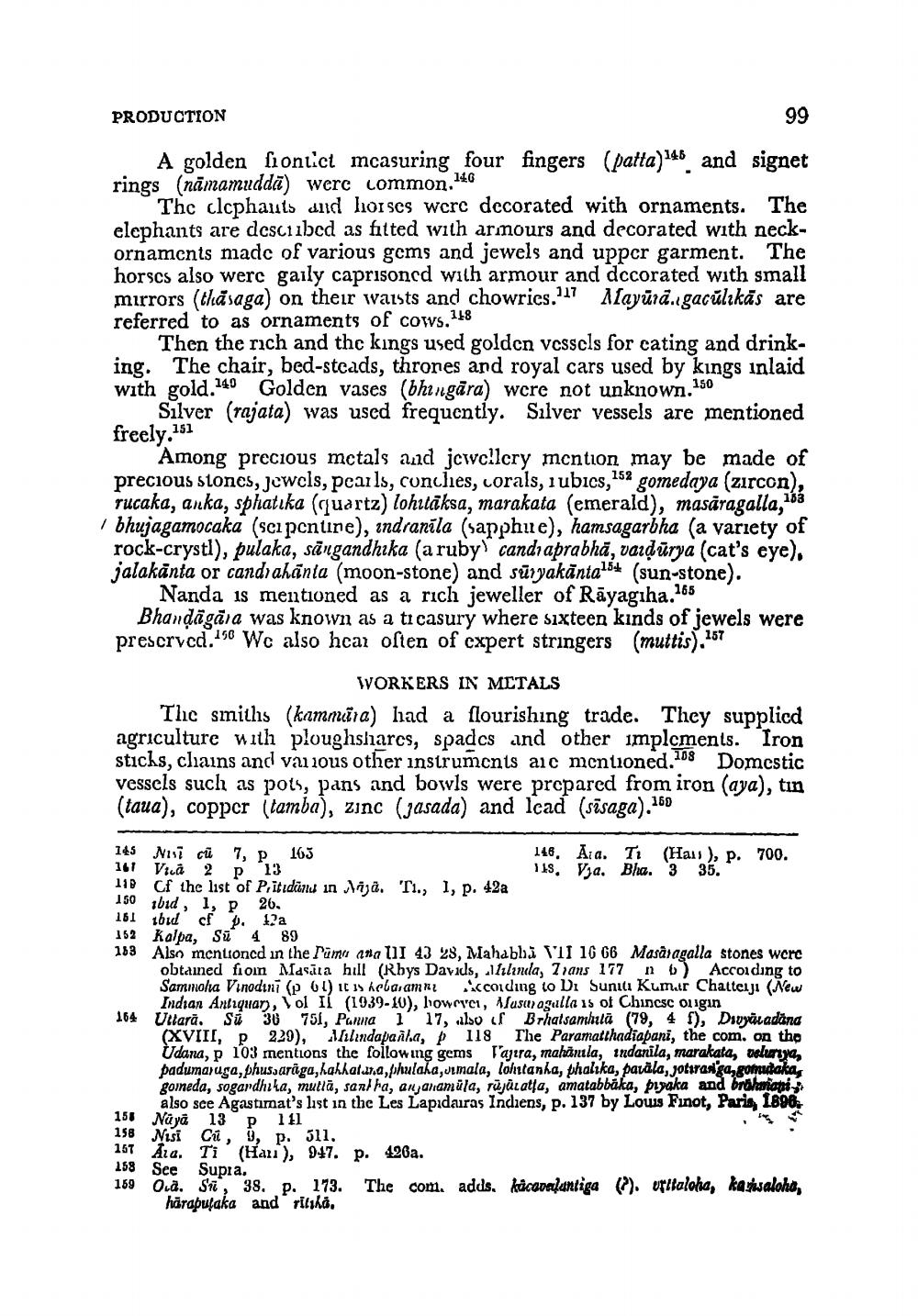________________
PRODUCTION
99
A golden fronlict mcasuring four fingers (patta) 146 and signet rings (nāmamudda) were common.140
Thc clcphauts and horses were decorated with ornaments. The elephants are desciibcd as fitted with armours and decorated with neckornaments made of various gems and jewels and upper garment. The horscs also were gaily caprisoned with armour and dccorated with small mirrors (thasaga) on their waists and chowries."7 Alayūrā. gacūlıkās are referred to as ornaments of cows. 148
Then the rich and the kings used goldcn vessels for cating and drinking. The chair, bed-stcads, thrones and royal cars used by kings inlaid with gold.140 Golden vases (bhingāra) were not unknown.150
Silver (rajata) was used frequently. Silver vessels are mentioned freely.151
Among precious mctals and jcwc!lcry mcntion may be made of precious stones, jewels, pearls, cunches, corals, i ubics, sa gomedaya (zircon), rucaka, anka, sphatika (quartz) lohitaksa, marakata (emerald), masāragalla,163 bhujagamocaka (sci pentine), indranila (sapphie), hamsagarbha (a variety of rock-crysti), pulaka, sängandhika (a ruby candiaprabhā, vaidūrya (cat's eye), jalakänta or candrahanta (moon-stone) and süryakānta154 (sun-stone).
Nanda is mentioned as a rich jeweller of Rāyagiha.165 Bhandägara was known as a ti casury where sixteen kinds of jewels were prescrvcd.150 Wc also hcar osten of expert stringers (muttis).157
WORKERS IN METALS The smiths (kammira) had a flourishing trade. They supplicd agriculture with ploughsharcs, spadcs and other implements. Iron sticks, chains and various other instruments aic mcntioned.108 Domestic vessels such as pots, pans and bowls were prepared from iron (aya), tin (taua), copper (tamba), zinc (Jasada) and Icad (sāsaga).160
145 161
150
161 152
153
164
W cũ 7, P 105
146, Aia. Ti (Haus ), p. 700. Vieå 2 P 13
119, Vya. Bha. 3 35. Cf the list of Pritidūnu in Vija. T., 1, p. 42a bid, , P 26. toid cf 12a Kalpa, si 4 89 Also mentioned in the rūmu ana III 43 28, Mahabhi VII 16 66 Masaragalla stones were obtained froin Masīta hill (Rhys Davids, llılında, Trans 1771 6) According to Sammolua Vinodini (p 6) it is keba,amaz According to Di Sunil Kumar Chatterji (New
Indian Antiquar), Vol II (1939-10), lowryci, Musa agulla is of Chinesc origin Urtarā. Sú 36 751, Panna l'17, also of Brhatsamhlā (79, 4 f), Dovyātadana
(XVIII, P 229), Malındapaxla, 118 The Paramatthadiapani, the com. on the Udana, p 103 mentions the following gems t'ajura, mahānila, indanila, marakata, uslunya, padumayuga, phussarāga, hahhatar.a, bhulaha,Jumala, lontanha, phalika, parāla, joturange, gomudaka, goineda, sogardhiha, mutlā, sani ha, anjanamüla, rūjūlatta, amatabbaka, plyaka and brahasiapis also sce Agastırat's list in the Les Lapidairas Indiens, p. 137 by Louis Finot, Paris, 1896. Naya 13 P 111 Nisi Cú, 9, p. 311, Aia. Ti (Han), 947. p. 426a. See Supra. Ova. Sr, 38. p. 173. The com. adds, kacamadurtiga ”). ofliolohe, kartwaloha,
häraputaka and rilika,
155
158
158
169




